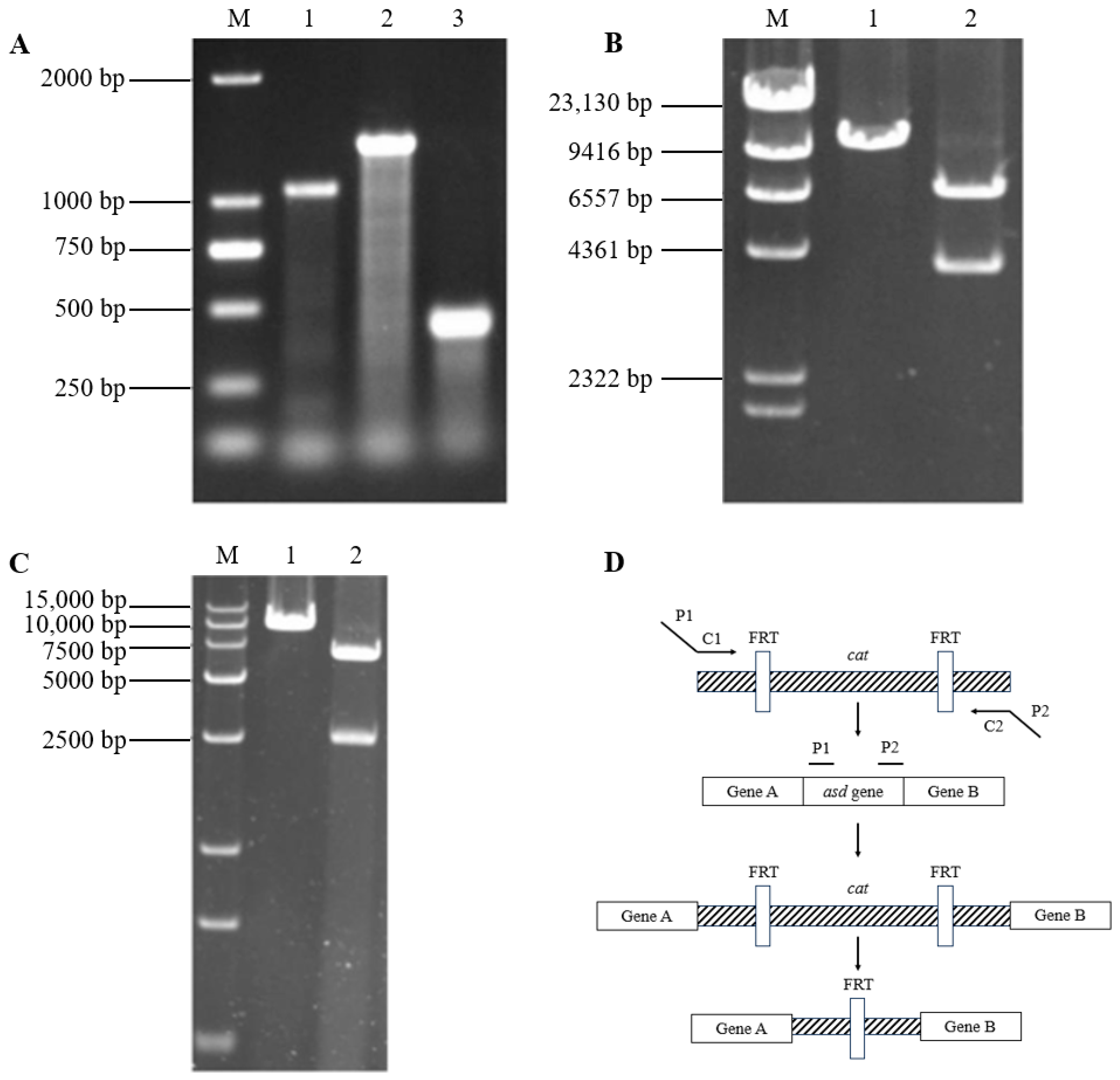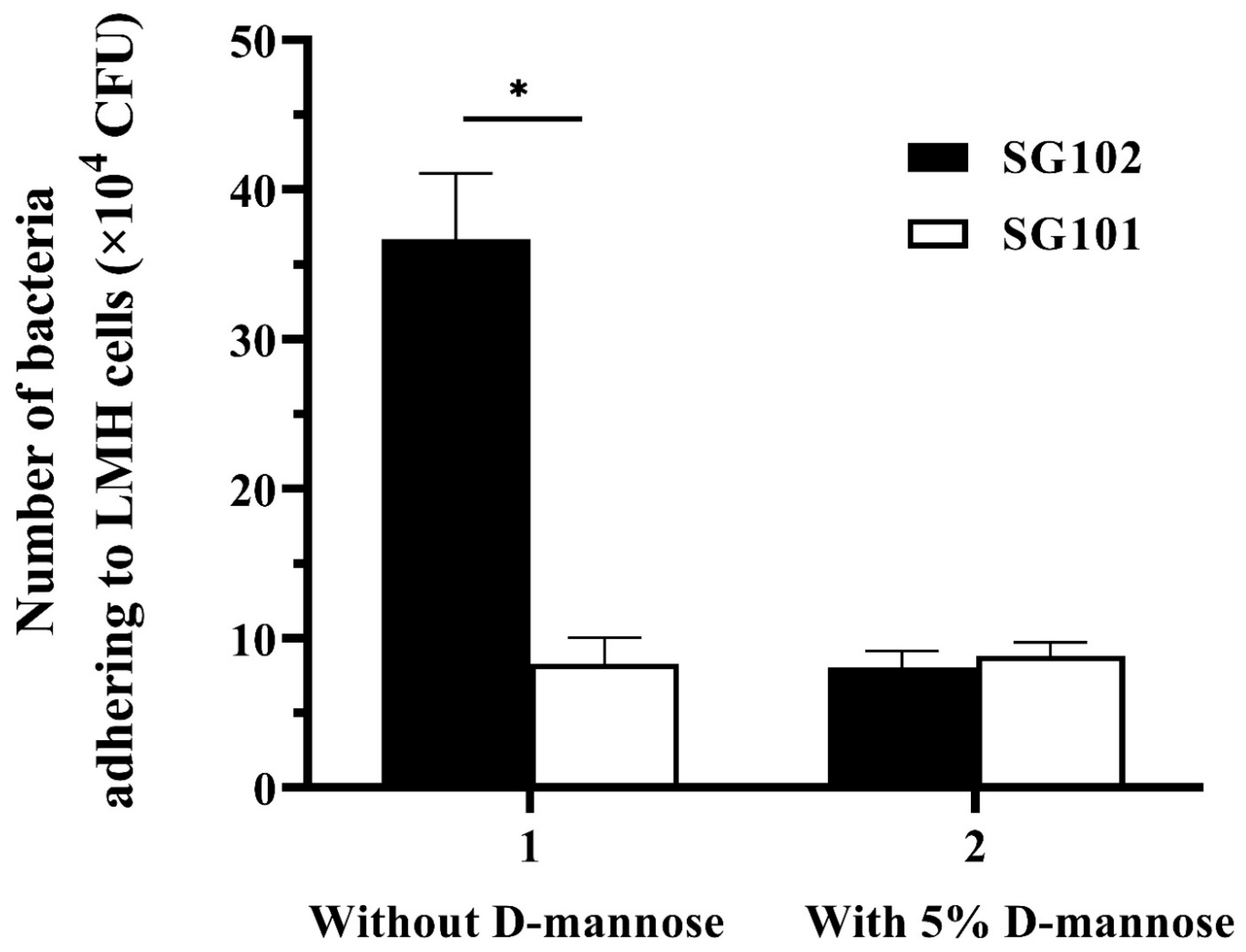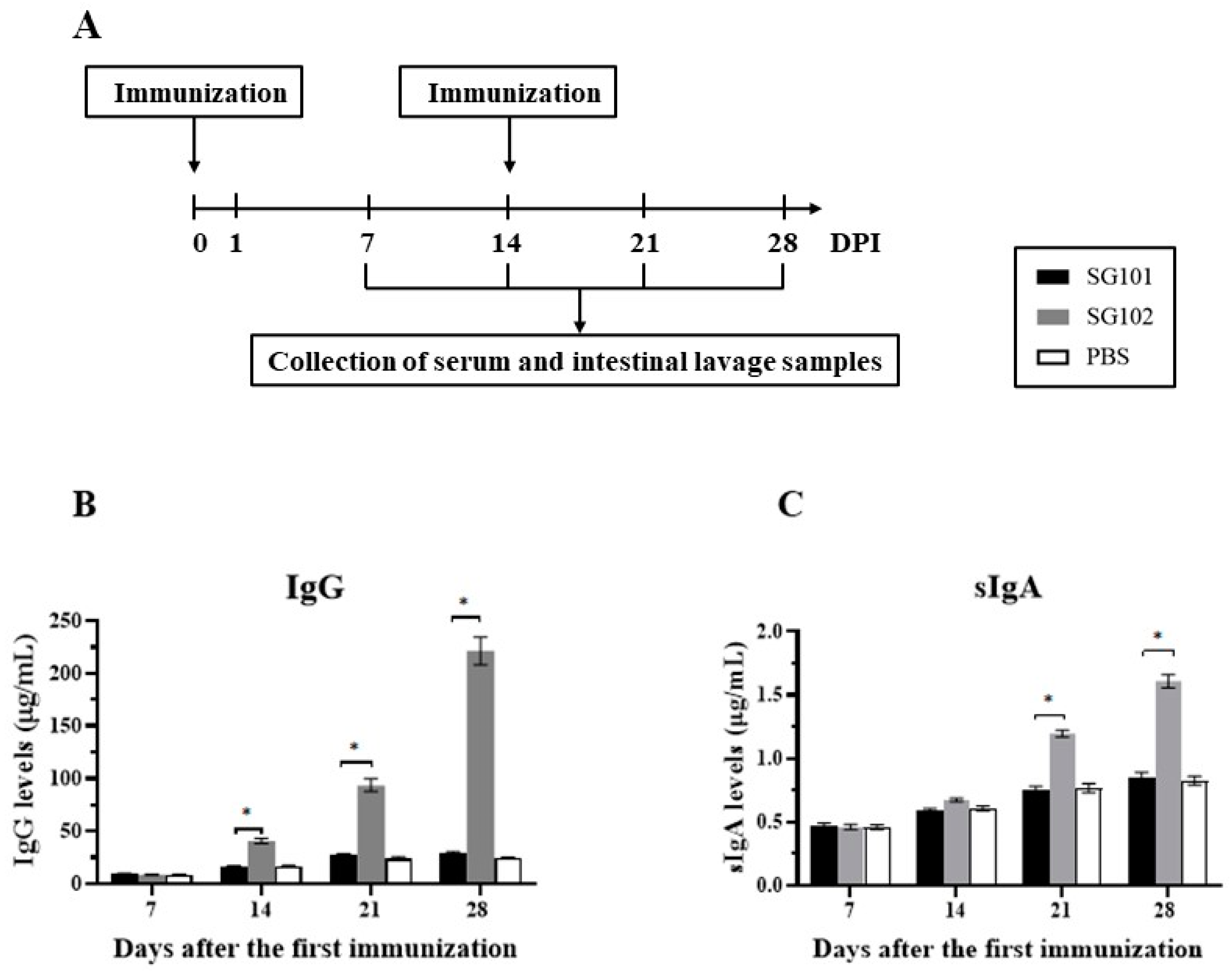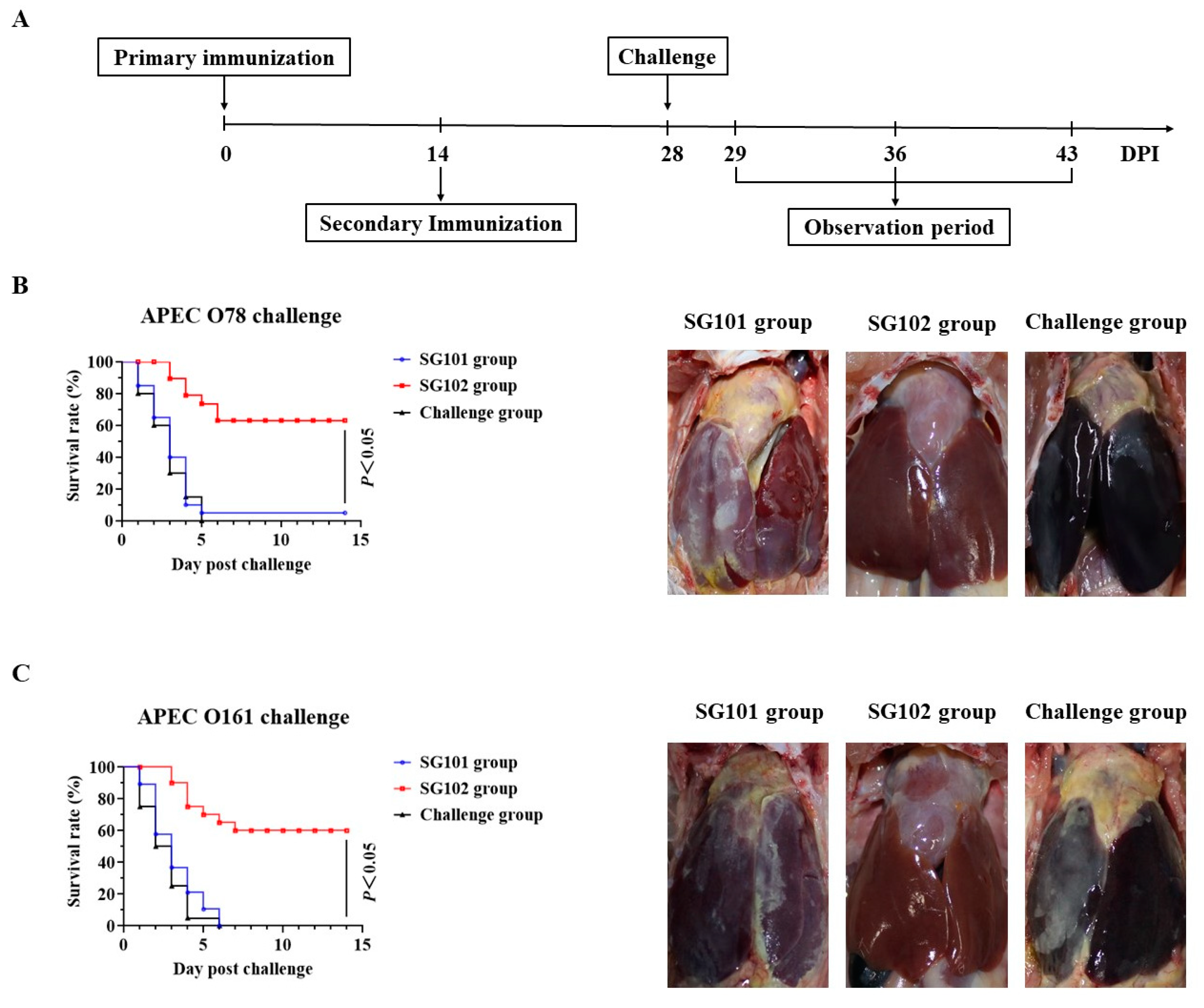Recombinant Salmonella gallinarum (S. gallinarum) Vaccine Candidate Expressing Avian Pathogenic Escherichia coli Type I Fimbriae Provides Protections against APEC O78 and O161 Serogroups and S. gallinarum Infection
Abstract
1. Introduction
2. Materials and Methods
2.1. Bacterial Strains, Plasmids, and Growth Conditions
2.2. Chickens
2.3. Cloning of APEC Type I Fimbriae Operon and Construction of Chromosome-Plasmid Balance Lethal System of SG01 asd Deletion Mutant
2.4. Identification of Type I Fimbriae Expression
2.5. Bacterial Adherence and Adherence Inhibition Assays
2.6. Safety and Virulence Assessment
2.7. Antigen-Specific Antibodies against Salmonella Vector Strain
2.8. Bacterial Vaccination and Measurements of Body Weight in Chickens
2.9. In Vivo Persistence of Bacteria in Chicken Tissues
2.10. Specific Humoral and Mucosal Immune Response
2.11. Protective Effects against APEC O78 and O161 Serogroups Challenge
2.12. Protective Effects against S. gallinarum Challenge
2.13. Statistical Analysis
3. Results
3.1. Identifications of Asd Deletion Mutant and Recombinant Plasmids
3.2. Verifications of APEC Type I Fimbriae Expression
3.3. Bacterial Adherence and Adherence Inhibition In Vitro
3.4. Virulence of Vaccine Candidate and Challenge Strains
3.5. Average Anti-Salmonella Peg Antibody Agglutination Titers of Chickens with Different Immune Periods
3.6. Body Weight Measurement and Bacterial Persistence in Chickens after Immunizations
3.7. Specific Immune Responses against APEC FimA
3.8. Protective Effects against APEC Infections
3.9. Protective Effect against S. gallinarum Challenge
4. Discussion
Supplementary Materials
Author Contributions
Funding
Institutional Review Board Statement
Informed Consent Statement
Data Availability Statement
Conflicts of Interest
References
- Guabiraba, R.; Schouler, C. Avian colibacillosis: Still many black holes. FEMS Microbiol. Lett. 2015, 362, fnv118. [Google Scholar] [CrossRef] [PubMed]
- Janßen, T.; Schwarz, C.; Preikschat, P.; Voss, M.; Philipp, H.C.; Wieler, L.H. Virulence-associated genes in avian pathogenic Escherichia coli (APEC) isolated from internal organs of poultry having died from colibacillosis. Int. J. Med. Microbiol. 2001, 291, 371–378. [Google Scholar] [CrossRef] [PubMed]
- Ghunaim, H.; Abu-Madi, M.; Kariyawasam, S. Advances in vaccination against avian pathogenic Escherichia coli respiratory disease: Potentials and limitations. Vet. Microbiol. 2014, 172, 13–22. [Google Scholar] [CrossRef] [PubMed]
- Fancher, C.; Zhang, L.; Kiess, A.; Adhikari, P.; Dinh, T.; Sukumaran, A. Avian Pathogenic Escherichia coli and Clostridium perfringens: Challenges in No Antibiotics Ever Broiler Production and Potential Solutions. Microorganisms 2020, 8, 1533. [Google Scholar] [CrossRef]
- Fancher, C.; Thames, H.; Colvin, M.; Smith, M.; Easterling, A.; Nuthalapati, N.; Zhang, L.; Kiess, A.; Dinh, T.; Theradiyil Sukumaran, A. Prevalence and Molecular Characteristics of Avian Pathogenic Escherichia coli in “No Antibiotics Ever” Broiler Farms. Microbiol. Spectr. 2021, 9, e0083421. [Google Scholar] [CrossRef]
- Kathayat, D.; Lokesh, D.; Ranjit, S.; Rajashekara, G. Avian pathogenic Escherichia coli (APEC): An overview of virulence and pathogenesis factors, zoonotic potential, and control strategies. Pathogens 2021, 10, 467. [Google Scholar] [CrossRef]
- Johnson, T.; Wannemuehler, Y.; Johnson, S.; Stell, A.; Doetkott, C.; Johnson, J.; Kim, K.; Spanjaard, L.; Nolan, L. Comparison of extraintestinal pathogenic Escherichia coli strains from human and avian sources reveals a mixed subset representing potential zoonotic pathogens. Appl. Environ. Microbiol. 2008, 74, 7043–7050. [Google Scholar] [CrossRef]
- Ewers, C.; Li, G.; Wilking, H.; Kiessling, S.; Alt, K.; Antáo, E.; Laturnus, C.; Diehl, I.; Glodde, S.; Homeier, T.; et al. Avian pathogenic, uropathogenic, and newborn meningitis-causing Escherichia coli: How closely related are they? Int. J. Med. Microbiol. 2007, 297, 163–176. [Google Scholar] [CrossRef]
- Apostolakos, I.; Laconi, A.; Mughini-Gras, L.; Yapicier, Ö.; Piccirillo, A. Occurrence of Colibacillosis in Broilers and Its Relationship with Avian Pathogenic Escherichia coli (APEC) Population Structure and Molecular Characteristics. Front. Vet. Sci. 2021, 8, 737720. [Google Scholar] [CrossRef]
- Azam, M.; Mohsin, M.; Johnson, T.; Smith, E.; Johnson, A.; Umair, M.; Saleemi, M.; Sajjad-Ur-Rahman. Genomic landscape of multi-drug resistant avian pathogenic Escherichia coli recovered from broilers. Vet. Microbiol. 2020, 247, 108766. [Google Scholar] [CrossRef]
- Kang, H.; Srinivasan, J.; Curtiss, R. Immune responses to recombinant pneumococcal PspA antigen delivered by live attenuated Salmonella enterica serovar typhimurium vaccine. Infect. Immun. 2002, 70, 1739–1749. [Google Scholar] [CrossRef] [PubMed]
- Han, Y.; Liu, Q.; Yi, J.; Liang, K.; Wei, Y.; Kong, Q. A biologically conjugated polysaccharide vaccine delivered by attenuated Salmonella typhimurium provides protection against challenge of avian pathogenic Escherichia coli O1 infection. Pathog. Dis. 2017, 75, ftx102. [Google Scholar] [CrossRef] [PubMed]
- Han, Y.; Liu, Q.; Willias, S.; Liang, K.; Li, P.; Cheng, A.; Kong, Q. A bivalent vaccine derived from attenuated Salmonella expressing O-antigen polysaccharide provides protection against avian pathogenic Escherichia coli O1 and O2 infection. Vaccine 2018, 36, 1038–1046. [Google Scholar] [CrossRef] [PubMed]
- Chen, H.; Schifferli, D. Mucosal and systemic immune responses to chimeric fimbriae expressed by Salmonella enterica serovar typhimurium vaccine strains. Infect. Immun. 2000, 68, 3129–3139. [Google Scholar] [CrossRef] [PubMed]
- Rizos, K.; Lattemann, C.; Bumann, D.; Meyer, T.; Aebischer, T. Autodisplay: Efficacious surface exposure of antigenic UreA fragments from Helicobacter pylori in Salmonella vaccine strains. Infect. Immun. 2003, 71, 6320–6328. [Google Scholar] [CrossRef]
- Sarowska, J.; Futoma-Koloch, B.; Jama-Kmiecik, A.; Frej-Madrzak, M.; Ksiazczyk, M.; Bugla-Ploskonska, G.; Choroszy-Krol, I. Virulence factors, prevalence and potential transmission of extraintestinal pathogenic Escherichia coli isolated from different sources: Recent reports. Gut Pathog. 2019, 11, 10. [Google Scholar] [CrossRef]
- Bessaiah, H.; Anamalé, C.; Sung, J.; Dozois, C. What Flips the Switch? Signals and Stress Regulating Extraintestinal Pathogenic Escherichia coli Type 1 Fimbriae (Pili). Microorganisms 2021, 10, 5. [Google Scholar] [CrossRef]
- Naveh, M.W.; Zusman, T.; Skutelsky, E.; Ron, E.Z. Adherence pili in avian strains of Escherichia coli: Effect on pathogenicity. Avian Dis. 1984, 28, 651–661. [Google Scholar] [CrossRef]
- Vidotto, M.C.; Navarro, H.R.; Gaziri, L.C. Adherence pili of pathogenic strains of avian Escherichia coli. Vet. Microbiol. 1997, 59, 79–87. [Google Scholar] [CrossRef]
- Pourbakhsh, S.; Boulianne, M.; Martineau-Doizé, B.; Fairbrother, J. Virulence mechanisms of avian fimbriated Escherichia coli in experimentally inoculated chickens. Vet. Microbiol. 1997, 58, 195–213. [Google Scholar] [CrossRef]
- Edelman, S.; Leskelä, S.; Ron, E.; Apajalahti, J.; Korhonen, T.K. In vitro adhesion of an avian pathogenic Escherichia coli O78 strain to surfaces of the chicken intestinal tract and to ileal mucus. Vet. Microbiol. 2003, 91, 41–56. [Google Scholar] [CrossRef]
- Wooley, R.; Spears, K.; Brown, J.; Nolan, L.; Fletcher, O. Relationship of complement resistance and selected virulence factors in pathogenic avian Escherichia coli. Avian Dis. 1992, 36, 679–684. [Google Scholar] [CrossRef] [PubMed]
- Gyimah, J.; Panigrahy, B. Immunogenicity of an Escherichia coli (serotype O1) pili vaccine in chickens. Avian Dis. 1985, 29, 1078–1083. [Google Scholar] [CrossRef] [PubMed]
- Gyimah, J.; Panigrahy, B.; Williams, J. Immunogenicity of an Escherichia coli multivalent pilus vaccine in chickens. Avian Dis. 1986, 30, 687–689. [Google Scholar] [CrossRef] [PubMed]
- Suwanichkul, A.; Panigrahy, B. Biological and immunological characterization of pili of Escherichia coli serotypes O1, O2, and O78 pathogenic to poultry. Avian Dis. 1986, 30, 781–787. [Google Scholar] [CrossRef] [PubMed]
- Vandemaele, F.; Vandekerchove, D.; Vereecken, M.; Derijcke, J.; Dho-Moulin, M.; Goddeeris, B. Sequence analysis demonstrates the conservation of fimH and variability of fimA throughout avian pathogenic Escherichia coli (APEC). Vet. Res. 2003, 34, 153–163. [Google Scholar] [CrossRef] [PubMed][Green Version]
- Matsuda, K.; Chaudhari, A.A.; Lee, J.H. Safety and efficacy of a virulence gene-deleted live vaccine candidate for fowl typhoid in young chickens. Avian Pathol. 2011, 40, 309–314. [Google Scholar] [CrossRef]
- Smith, H.W. The use of live vaccines in experimental Salmonella gallinarum infection in chickens with observations on their interference effect. J. Hyg. 1956, 54, 419–432. [Google Scholar] [CrossRef]
- Van Immerseel, F.; Studholme, D.J.; Eeckhaut, V.; Heyndrickx, M.; Dewulf, J.; Dewaele, I.; Van Hoorebeke, S.; Haesebrouck, F.; Van Meirhaeghe, H.; Ducatelle, R. Salmonella gallinarum field isolates from laying hens are related to the vaccine strain SG9R. Vaccine 2013, 31, 4940–4945. [Google Scholar] [CrossRef]
- Kwon, H.J.; Cho, S.H. Pathogenicity of SG 9R, a rough vaccine strain against fowl typhoid. Vaccine 2011, 29, 1311–1318. [Google Scholar] [CrossRef]
- Dai, P.; Wu, H.-C.; Ding, H.-C.; Li, S.-J.; Bao, E.-D.; Yang, B.-S.; Li, Y.-J.; Gao, X.-L.; Duan, Q.-D.; Zhu, G.-Q. Safety and protective effects of an avirulent Salmonella gallinarum isolate as a vaccine candidate against Salmonella gallinarum infections in young chickens. Vet. Immunol. Immunopathol. 2022, 253, 110501. [Google Scholar] [CrossRef] [PubMed]
- Gu, X.; Hou, Q.; Liu, J.; Xia, P.; Duan, Q.; Zhu, G. Sef fimbria operon construction, expression, and function for direct rapid detection of Salmonella enteritidis. Appl. Microbiol. Biotechnol. 2021, 105, 5631–5641. [Google Scholar] [CrossRef] [PubMed]
- Nakayama, K.; Kelly, S.M.; Curtiss, R. Construction of an ASD+ Expression-Cloning Vector: Stable Maintenance and High Level Expression of Cloned Genes in a Salmonella Vaccine Strain. Nat. Biotechnol. 1988, 6, 693–697. [Google Scholar] [CrossRef]
- Datsenko, K.; Wanner, B. One-step inactivation of chromosomal genes in Escherichia coli K-12 using PCR products. Proc. Natl. Acad. Sci. USA 2000, 97, 6640–6645. [Google Scholar] [CrossRef] [PubMed]
- Hagberg, L.; Jodal, U.; Korhonen, T.K.; Lidin-Janson, G.; Edén, C. Adhesion, hemagglutination, and virulence of Escherichia coli causing urinary tract infections. Infect. Immun. 1981, 31, 564–570. [Google Scholar] [CrossRef] [PubMed]
- Michele, M.; Raymond, J. Inhibition of mannose-resistant haemagglutination of sheep erythrocytes by enterotoxigenic Escherichia coli in the presence of plasma glycoprotein glycans. FEMS Microbiol. Lett. 1986, 37, 145–149. [Google Scholar]
- Zhou, M.; Duan, Q.; Zhu, X.; Guo, Z.; Li, Y.; Hardwidge, P.; Zhu, G. Both flagella and F4 fimbriae from F4ac+ enterotoxigenic Escherichia coli contribute to attachment to IPEC-J2 cells in vitro. Vet. Res. 2013, 44, 30. [Google Scholar] [CrossRef]
- Xuehong, D.; Min, T.; Ce, J.I.; Wenyuan, M.A.; Qinghua, Z. The comparative study on the LD_(50) to evaluate the virulence of Vibrio parahaemolyticus using two calculation methods. J. Shanghai Ocean Univ. 2016, 25, 86–96. [Google Scholar]
- Yang, B.; Niu, Q.; Yang, Y.; Dai, P.; Yuan, T.; Xu, S.; Pan, X.; Yang, Y.; Zhu, G. Self-made Salmonella pullorum agglutination antigen development and its potential practical application. Poult. Sci. 2019, 98, 6326–6332. [Google Scholar] [CrossRef]
- Matsuda, K.; Chaudhari, A.A.; Lee, J.H. Evaluation of safety and protection efficacy on cpxR and lon deleted mutant of Salmonella gallinarum as a live vaccine candidate for fowl typhoid. Vaccine 2011, 29, 668–674. [Google Scholar] [CrossRef]
- Chen, X.; Liu, W.; Li, H.; Yan, S.; Jiang, F.; Cai, W.; Li, G. Whole genome sequencing analysis of avian pathogenic Escherichia coli from China. Vet. Microbiol. 2021, 259, 109158. [Google Scholar] [CrossRef]
- Krishnegowda, D.N.; Singh, B.; Mariappan, A.; Munuswamy, P.; Singh, K.; Sahoo, M.; Saminathan, M.; Ramalingam, R.; Chellappa, M.; Singh, V.; et al. Molecular epidemiological studies on avian pathogenic Escherichia coli associated with septicemia in chickens in India. Microb. Pathog. 2022, 162, 105313. [Google Scholar] [CrossRef]
- Kazibwe, G.; Katami, P.; Alinaitwe, R.; Alafi, S.; Nanteza, A.; Nakavuma, J. Bacteriophage activity against and characterisation of avian pathogenic Escherichia coli isolated from colibacillosis cases in Uganda. PLoS ONE 2020, 15, e0239107. [Google Scholar] [CrossRef]
- Wang, X.; Liao, X.; Zhang, W.; Jiang, H.; Sun, J.; Zhang, M.; He, X.; Lao, D.; Liu, Y. Prevalence of serogroups, virulence genotypes, antimicrobial resistance, and phylogenetic background of avian pathogenic Escherichia coli in south of China. Foodborne Pathog. Dis. 2010, 7, 1099–1106. [Google Scholar] [CrossRef]
- Cordoni, G.; Woodward, M.; Wu, H.; Alanazi, M.; Wallis, T.; La Ragione, R. Comparative genomics of European avian pathogenic E. coli (APEC). BMC Genom. 2016, 17, 960. [Google Scholar] [CrossRef]
- Wang, Z.; Zheng, X.; Guo, G.; Hu, Z.; Miao, J.; Dong, Y.; Xu, Z.; Zhou, Q.; Wei, X.; Han, X.; et al. O145 may be emerging as a predominant serogroup of Avian pathogenic Escherichia coli (APEC) in China. Vet. Microbiol. 2022, 266, 109358. [Google Scholar] [CrossRef]
- Clark-Curtiss, J.; Curtiss, R. Salmonella Vaccines: Conduits for Protective Antigens. J. Immunol. 2018, 200, 39–48. [Google Scholar] [CrossRef]
- Ashkar, A.; Mossman, K.; Coombes, B.; Gyles, C.; Mackenzie, R. FimH adhesin of type 1 fimbriae is a potent inducer of innate antimicrobial responses which requires TLR4 and type 1 interferon signalling. PLoS Pathog. 2008, 4, e1000233. [Google Scholar] [CrossRef]
- Tchesnokova, V.; Aprikian, P.; Kisiela, D.; Gowey, S.; Korotkova, N.; Thomas, W.; Sokurenko, E. Type 1 fimbrial adhesin FimH elicits an immune response that enhances cell adhesion of Escherichia coli. Infect. Immun. 2011, 79, 3895–3904. [Google Scholar] [CrossRef]
- Zhang, W.; Xu, L.; Park, H.; Hwang, J.; Kwak, M.; Lee, P.; Liang, G.; Zhang, X.; Xu, J.; Jin, J. Escherichia coli adhesion portion FimH functions as an adjuvant for cancer immunotherapy. Nat. Commun. 2020, 11, 1187. [Google Scholar] [CrossRef]
- Jia, B.; McNeil, L.; Dupont, C.; Tsioris, K.; Barry, R.; Scully, I.; Ogunniyi, A.; Gonzalez, C.; Pride, M.; Gierahn, T.; et al. Longitudinal multiparameter single-cell analysis of macaques immunized with pneumococcal protein-conjugated or unconjugated polysaccharide vaccines reveals distinct antigen specific memory B cell repertoires. PLoS ONE 2017, 12, e0183738. [Google Scholar] [CrossRef] [PubMed]
- Jackson, L.; Gurtman, A.; van Cleeff, M.; Frenck, R.; Treanor, J.; Jansen, K.; Scott, D.; Emini, E.; Gruber, W.; Schmoele-Thoma, B. Influence of initial vaccination with 13-valent pneumococcal conjugate vaccine or 23-valent pneumococcal polysaccharide vaccine on anti-pneumococcal responses following subsequent pneumococcal vaccination in adults 50 years and older. Vaccine 2013, 31, 3594–3602. [Google Scholar] [CrossRef] [PubMed]






| Strains and Plasmids | Desciption | Source |
|---|---|---|
| Strains | ||
| SG01 | S. gallinarum isolate with deficiency of fimH | [31] |
| SG100 | Δasd mutant of SG01 | This study |
| SG101 | SG100 containing pYA3342 | This study |
| SG102 | SG100 containing recombinant pYA3342 expressing APEC type I fimbriae operon | This study |
| SG103 | SG100 containing recombinant pYA3342 expressing APEC fimA | Lab stock |
| U20 | S. gallinarum, virulent strain | [31] |
| DH5αΔasd | Δasd mutant of DH5α | Lab stock |
| QD2 | APEC O78 serotype, isolated from chickens | Song Gao |
| O161 | APEC O161 serotype, isolated from chickens | Song Gao |
| SE5000 | E. coli, genetic engineering strain without fimbriae | Lab stock |
| SE5000 (pBR322-APEC fim) | SE5000 containing recombinant pBR322 expressing APEC type I fimbriae operon; growing in LB broth with AmpR | This study |
| Plasmids | ||
| pBR322 | expression vector; AmpR, TcR | Lab stock |
| pBR322-APEC fim | pBR322 derivative containing APEC type I fimbriae operon cluster; AmpR | This study |
| pYA3342 | asd+ vector, pBR ori | Dieter M. Schifferli |
| pYA3342-APEC fim | pYA3342 derivative containing APEC type I fimbriae operon | This study |
| pKD3 | oriR6Kγ; AmpR, CmR | [34] |
| pKD46 | PBAD-gam-beta-exo oriR101 repA101LS; AmpR | [34] |
| pCP20 | cI857 λPR flp oripSC101ts; AmpR, CmR | [34] |
| Strain | Erythrocyte Hemagglutination Test a | Antigen-Antibody Agglutination Test b |
|---|---|---|
| SG01 | − c | − |
| SG101 | − | − |
| SG102 | + d | + |
| SG103 | − | − |
| Strains | Inoculation Route | Chicken Age | Inoculation Dose (CFU) | Number of Deaths/Total Numbers of Chickens | LD50 (CFU) |
|---|---|---|---|---|---|
| SG101 | Oral inoculation | 1-day-old | 1 × 108 | 0/10 | >1 × 1011 |
| 1 × 109 | 0/10 | ||||
| 1 × 1010 | 0/10 | ||||
| 1 × 1011 | 0/10 | ||||
| SG102 | Oral inoculation | 1-day-old | 1 × 108 | 0/10 | >1 × 1011 |
| 1 × 109 | 0/10 | ||||
| 1 × 1010 | 0/10 | ||||
| 1 × 1011 | 0/10 | ||||
| QD2 | posterior chest air sac injection | 30-day-old | 1 × 107 | 0/10 | 4.87 × 108 |
| 1 × 108 | 2/10 | ||||
| 1 × 109 | 6/10 | ||||
| 1 × 1010 | 10/10 | ||||
| O161 | posterior chest air sac injection | 30-day-old | 1 × 107 | 3/10 | 5.41 × 107 |
| 1 × 108 | 5/10 | ||||
| 1 × 109 | 9/10 | ||||
| 1 × 1010 | 10/10 |
Disclaimer/Publisher’s Note: The statements, opinions and data contained in all publications are solely those of the individual author(s) and contributor(s) and not of MDPI and/or the editor(s). MDPI and/or the editor(s) disclaim responsibility for any injury to people or property resulting from any ideas, methods, instructions or products referred to in the content. |
© 2023 by the authors. Licensee MDPI, Basel, Switzerland. This article is an open access article distributed under the terms and conditions of the Creative Commons Attribution (CC BY) license (https://creativecommons.org/licenses/by/4.0/).
Share and Cite
Dai, P.; Wu, H.; Ding, G.; Fan, J.; Li, Y.; Li, S.; Bao, E.; Li, Y.; Gao, X.; Li, H.; et al. Recombinant Salmonella gallinarum (S. gallinarum) Vaccine Candidate Expressing Avian Pathogenic Escherichia coli Type I Fimbriae Provides Protections against APEC O78 and O161 Serogroups and S. gallinarum Infection. Vaccines 2023, 11, 1778. https://doi.org/10.3390/vaccines11121778
Dai P, Wu H, Ding G, Fan J, Li Y, Li S, Bao E, Li Y, Gao X, Li H, et al. Recombinant Salmonella gallinarum (S. gallinarum) Vaccine Candidate Expressing Avian Pathogenic Escherichia coli Type I Fimbriae Provides Protections against APEC O78 and O161 Serogroups and S. gallinarum Infection. Vaccines. 2023; 11(12):1778. https://doi.org/10.3390/vaccines11121778
Chicago/Turabian StyleDai, Peng, Hucong Wu, Guowei Ding, Juan Fan, Yuhe Li, Shoujun Li, Endong Bao, Yajie Li, Xiaolei Gao, Huifang Li, and et al. 2023. "Recombinant Salmonella gallinarum (S. gallinarum) Vaccine Candidate Expressing Avian Pathogenic Escherichia coli Type I Fimbriae Provides Protections against APEC O78 and O161 Serogroups and S. gallinarum Infection" Vaccines 11, no. 12: 1778. https://doi.org/10.3390/vaccines11121778
APA StyleDai, P., Wu, H., Ding, G., Fan, J., Li, Y., Li, S., Bao, E., Li, Y., Gao, X., Li, H., Zhu, C., & Zhu, G. (2023). Recombinant Salmonella gallinarum (S. gallinarum) Vaccine Candidate Expressing Avian Pathogenic Escherichia coli Type I Fimbriae Provides Protections against APEC O78 and O161 Serogroups and S. gallinarum Infection. Vaccines, 11(12), 1778. https://doi.org/10.3390/vaccines11121778




